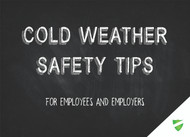Staying Safe in Winter: Protecting Your Workers
As winter arrives, prioritizing the well-being of your employees, especially those working outdoors during the colder months, is crucial. This blog explores essential cold weather safety tips for employees, emphasizing workplace safety awareness and practical winter safety tips in the workplace. We'll also highlight the importance of equipping your team with appropriate gear, such as warm gloves, bright high-visibility clothing, and heated vests, to ensure safety while working in cold environments.
Understanding the Risks of Cold Weather:
Working in cold conditions, particularly during winter months, exposes employees to risks like hypothermia, frostbite, trench foot, and chilblains. These cold-induced illnesses, highlighted in OSHA’s Cold Stress Guide, can significantly impact outdoor workers, emphasizing the need for robust cold weather safety tips in the workplace.
- Hypothermia: Occurs with rapid heat loss, leading to a dangerous drop in body temperature.
- Frostbite: Caused by prolonged exposure to freezing temperatures.
- Trench Foot: Results from extended exposure to wet and cold conditions.
- Chilblains: Develop due to repeated exposure to cold air temperatures.
*Chilblains (perniosis) are itchy red swellings caused by excessive constriction of the small blood vessels below the skin's surface.”
Employer Responsibilities for Cold Weather Safety:
Employers are tasked with ensuring a safe work environment, particularly when it comes to working outside in cold weather. This includes developing comprehensive cold weather safety plans, enforcing safe work practices, and providing essential training and equipment.
Essential Safety Gear for Cold Weather:
- Warm Gloves: Essential for maintaining dexterity in cold conditions.
- Bright Clothing: High-visibility apparel is crucial for low-light winter months.
- Heated Vests: Provide additional warmth, crucial for working in the cold.
- Insulated Bibs: Offer full-body protection against cold weather.
- Foot Traction Devices: Essential for navigating icy surfaces and preventing slips.
- Warm Hats & Hard Hat Liners: Protect against extreme cold and wind.
- Portable Heaters: Useful for stationary outdoor workspaces.
- Wind-Resistant Jackets: Guard against cold winds and snow.
- Warm Underwear: Moisture-wicking materials are key for maintaining dryness.
Hydrating in Cold Weather:
An often-overlooked aspect of cold weather safety is the importance of staying hydrated. Even in colder temperatures, outdoor workers can become dehydrated, which can lead to decreased performance and increased risk of cold-related illnesses. Sqwincher, a specialized electrolyte replacement drink, is an excellent solution for maintaining hydration levels in cold environments. Unlike traditional water or sports drinks, Sqwincher is designed to replenish the minerals and electrolytes lost during physical labor, making it particularly beneficial for skilled tradespeople who spend extended periods working outdoors. Its unique formulation helps maintain fluid balance, energy, and stamina, which are crucial for safety and effectiveness in demanding winter conditions.
Preventing Cold-Related Injuries:
Proactive measures are necessary to mitigate cold-induced injuries. This includes encouraging employees to wear layered, loose-fitting clothing and investing in quality insulated gear. Regular well-being checks and prompt reporting of cold stress symptoms are vital.
Daily Safety Practices:
Monitoring weather forecasts and adjusting work schedules to suit changing temperatures and wind conditions is a key part of workplace safety awareness. Open communication about weather changes and safety is essential.
Cold Weather Safety Tips:
Educating employees on winter safety, such as defensive driving in snow and ice, administering first aid for frostbite, and recognizing signs of cold-related illness, is crucial. Establishing communication protocols for severe weather conditions enhances overall safety.
Skilled Trades Working Outdoors:
Several skilled trades typically involve outdoor work, even in winter. These include:
- Construction Workers: Often work in exposed environments. They should wear insulated, waterproof clothing and use portable heaters where possible.
- Utility Line Technicians: Responsible for maintaining essential services, they need to wear specialized gear for both warmth and safety.
- Landscapers: Although less active in winter, they may need to manage snow and ice removal.
- Emergency Responders: Always on call, they require quick-access to warm gear and emergency kits.
For each of these trades, specific safety measures like wearing layered clothing, using insulated footwear, and taking regular breaks in warm areas are crucial to prevent cold stress.
Assessing Work Conditions:
Employers should assess factors like temperature, wind speed, and exposure to determine if conditions are too cold for safe work. Understanding OSHA's guidelines on cold weather safety is crucial for compliance and protection.
Winter Emergency Preparedness:
Winter emergency kits should include essentials like blankets, hand warmers, and waterproof flashlights. Encouraging employees to carry extra clothes and snacks enhances personal safety.
Leveraging Technology for Safety:
Using technology, such as mass notification systems, ensures efficient communication during emergencies. Soliciting employee feedback on safety tools and protocols is also beneficial.
Maintaining Safe Work Environments:
Ensuring well-lit, safe walking surfaces is crucial to prevent falls in winter conditions. Training employees to recognize and respond to frostbite and hypothermia is equally important.
Becoming Experts in Cold Stress Prevention:
Incorporating these comprehensive winter safety tips for employees and providing the right gear fosters a safer, more productive work environment. Safety is a collective responsibility, and together, we can effectively reduce the risks associated with working in cold weather.
For further questions or expert advice on cold weather safety tips for employees and cold stress prevention, contact our experts at Safety Services Inc.

